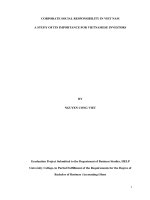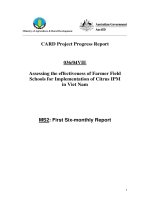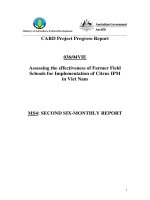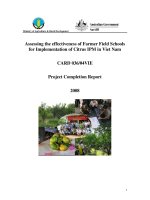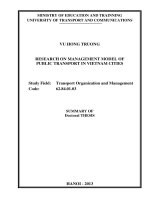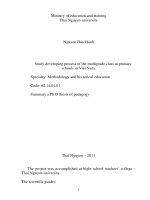Determinants of financial distress a study of listed companies in viet nam
Bạn đang xem bản rút gọn của tài liệu. Xem và tải ngay bản đầy đủ của tài liệu tại đây (562.04 KB, 53 trang )
MINISTRY OF EDUCATION AND TRAINING
UNIVERSITY OF ECONOMICS HOCHIMINH CITY
----------------
TRẦN THỊ KIM PHƯỢNG
DETERMINANTS OF FINANCIAL
DISTRESS: A STUDY OF LISTED
COMPANIES IN VIET NAM
ECONOMICS MASTER THESIS
Major: Business Administration
Ho Chi Minh City - 2012
MINISTRY OF EDUCATION AND TRAINING
UNIVERSITY OF ECONOMICS HO CHI MINH CITY
----------------
TRẦN THỊ KIM PHƯỢNG
DETERMINANTS OF FINANCIAL
DISTRESS: A STUDY OF LISTED
COMPANIES IN VIET NAM
ECONOMICS MASTER THESIS
Major: Business Administration
Major Code: 60.34.05
INSTRUCTOR: Võ Xuân Vinh, Ph.D
Ho Chi Minh City - 2012
i
ABSTRACT
This study focuses on researching the relationship between a set
financial ratios and the probability of failure companies. Through the Logistic
regression method, the results show that EPS, Cash per shares and Asset
turnover are the most important financial ratios, which help investors to
identify the financial distress of listed companies in Vietnam Stock Exchange.
ii
ACKNOWLEGEMENTS
During the time for conducting my thesis, I have been strongly
supported by many people. Through these words, I would like to extend my
sincere to all of them. The first one I would like to express my sincere
gratitude is my direct supervisor PhD. Vo Xuan Vinh, who provides me his
great guidance day by day until completing the thesis.
The next ones I would like to express my special gratitude are my
family, who are always by my side and encourage me if necessary.
Last but not least, my thesis would be nothing without the enthusiasm
and information from my friends.
Tran Thi Kim Phuong
Ho Chi Minh City, December 2012
iii
STUDENT DECLARATION
I hereby declare that the content in this thesis is my own, except for
special references, quotations and summaries. All data, references using in
this research are clearly identified. The thesis has not been accepted for any
degree until now.
SIGNED: .............................................................
DATE:..........................
iv
TABLE OF CONTENT
ABSTRACT .............................................................................................................. i
ACKNOWLEGEMENTS ........................................................................................ ii
STUDENT DECLARATION ................................................................................. iii
TABLE OF CONTENT .......................................................................................... iv
LIST OF TABLES .................................................................................................. vi
Chapter 1: Introduction of the study ........................................................................ 1
1.1
Rationale of the study ............................................................................................. 1
1.2
Research objectives and questions ......................................................................... 4
a)
Research objectives .................................................................................. 4
b)
Research questions.................................................................................... 4
1.3
Structure of the study ............................................................................................. 4
Chapter 2: Literature Review ................................................................................... 5
2.1 Definition of financial distress ................................................................................... 5
2.2 Ratios in designing models ........................................................................................ 9
2.3 Techniques used in financial distress predictions .................................................... 12
2.4 Hypotheses ............................................................................................................... 15
2.5 Conclusions .............................................................................................................. 16
Chapter 3. Research Methods ................................................................................ 17
3.1 The model ................................................................................................................ 17
3.2 Selection of predictor variables................................................................................ 18
3.3 Data set ..................................................................................................................... 20
Chapter 4. Data analysis and Findings ................................................................... 23
v
4.1 Descriptive Statistics................................................................................................ 23
4.2
Correlations .......................................................................................................... 24
4.3
Regression model ................................................................................................. 25
Chapter 5. Conclusions ...........................................................................................30
5.1
Summary .............................................................................................................. 30
5.2
Limitation of the research study........................................................................... 31
REFERENCES ........................................................................................................33
APPENDICES ........................................................................................................36
vi
LIST OF TABLES
Table 1 Summary statistics........................................................................................ 23
Table 2 Variable correlation. ..................................................................................... 25
Table 3 The performance of logistic regression for 8 models ................................... 26
vii
LIST OF ABBREVIATIONS
HOSE: Ho Chi Minh City Stock Exchange
MDA: Multiple Discriminant Analysis
ANN: Artificial Neural Networks
WOCA: Working capital
GROPROM: Gross profit margin
EPS: Earnings per share
DEBTTOTAL: Total debt to total assets
CASPSHARE: Cash flow per share
ATURNOVER: Asset turnover
SALEPERCA: Sales per cash
SALEPERRE: Sales per receivables
1
Chapter 1: Introduction of the study
1.1 Rationale of the study
The concept of “stock market” in the modern economy is the location
for the trading activities of medium and long – term securities. The market
participants including individual and institutional investors such as the mutual
funds and the insurance companies perform the purchases and sale of stock
for many different purposes involved in a good profit or taking over the
control of the enterprise. However, the most benefit from the establishment of
stock market is to bring the flexible source of capital financing the business’
operations. For this reason, hundreds of the stock market has been set up after
the first one, New York Stock Exchange (NYSE), and contributed
significantly to the national economies.
With the awareness of the stock market’s important role, the Securities
Trading Center in Ho Chi Minh City, now called Ho Chi Minh City Stock
Exchange (HOSE), was established under the Decision No. 127/1998/QDTTg dated 11/07/1998 and formally put into operation on 28/07/2000 with
only two listed companies. From now on HOSE has many remarkable
achievements. For example, until 31/12/2007, there were about 507 listed
companies with a total market value of 365 trillion, 3 securities investment
funds and 366 the variety of bonds. The number of investor accounts opened
at the securities companies were nearly 298 thousand accounts including over
7000 foreign investors. Vietnam Index, which represents the performance of
Vietnamese companies trading on the Ho Chi Minh Stock Exchange, has
2
increased continuously in that period. This is the most splendid stage in the
development of Vietnam Stock Exchange.
However, after a rapid and hot growth, the Vietnamese Stock Market in
2008 ended with a sharp decline and many listed companies have faced to
financial difficulties. Under the major impact of the economic crisis, the total
profit of all listed companies decreased to 30%. At the end of 2009, 23 out of
329 listed companies announced loss.
The financial distress companies can cause some great damages to the
market participants such as shareholders, creditors, managers, especially
individual investors. How do these investors protect them from this bad
damage? Through many researches, one conclusion is declared that firms in
the financially distress state have some particular characteristics relevant to
losses, a high leverage, low and volatile stock returns, etc. Recognizing these
signs is a way for warning not only investors but also enterprises in operation
as well. Thus, there have been a number of qualitative and quantitative
researches conducted to identify failing firms.
However, the two most popular methods are Multiple Discriminant
Analysis and Logistic regression. These techniques combined with a set of
financial ratios come up with the most famous two models, Altman’s Z score
model (Altman 1968) and Ohlson’s model (Ohlson 1980). The research by
Beaver (1966) and Altman (1968) focus on the main problem that is the
predictable ability of model developed from financial ratios. Based on this
classic research, the Z score model have been developed carefully through
further studies of some researchers including Deakin (1972), Taffler ( 1985 ),
Goudie (1987), Grice and Ingram (2001), Agarwal and Taffler (2007), and
Sandin and Porporato (2007).
3
Similarly, other studies also have been performed relating to the
Ohlson, including Lau (1987), Fauzias and Chin (2002), Boritz, Kennedy, and
Sun (2007), Muller, Steyn-Bruwer, and Hamman (2009).
Nowadays, these financial distress techniques have been applied for
many economical purposes. One of them is for credit analysis in financial
institutions. If customers want to borrow loans, the financial institutions
evaluate the credit worthiness of customers. In case of detecting the potential
of falling into financial distress, some preventive methods may be
implemented. For example, they can reject loan applications or borrowers
must take more steps aiming to avoiding loan defaults before receiving
money.
So which technique is the precise one? That is the argumentative
question. Each of them has its own advantages and disadvantages. The
effectiveness of the methods might be high or low at different times. The
reason for this is that a person’s reaction to information is difficult to forecast.
In a person’s behaviors, some basic trends and random elements stay together.
With a collection of millions of investors, the probability of forecasting their
behaviors is not as exact as predicting one person’s behaviors. Results from
each research also depend on other factors such as the characteristics of each
stock market, time for collecting data, etc.
For a long time, applying these techniques in predicting financial
distress to Vietnam Stock Exchange is still not much while many publicly
listed companies have fallen in to this stage. As a result, it is worthy to
provide a research aiming to investigate the role of financial ratios in
predicting financial distress, which is definitely relevant and useful for both
4
private entities and governmental institutions for assessing firms’ financial
condition as well.
1.2 Research objectives and questions
a) Research objectives
By means of the prior researches, the thesis’ primary objective is to
clarify the relationship between financial ratios and the financially distress of
listed companies in Viet Nam
b) Research questions
- Which is the suitable method to evaluate the impact of financial
ratios on the probability of failure ?
- How is the relationship between the financial ratios and the financial
distress state of companies?
1.3 Structure of the study
This research is divided into 4 chapters. Chapter 1 relates to introduce
the general content of the research with research problem, research questions,
and research objectives. A literature review of the financial distress prediction
is scanned in Chapter 2. Chapter 3 reveals analyses the data collected, and the
final result of the research. Chapter 4 discusses conclusions and implications
of the research.
5
Chapter 2: Literature Review
2.1 Definition of financial distress
It can be said that there are many definitions used in researches
regarding financial distress. Dun and Bradstreet (1985) clarify the financial
distress as the discontinuity of the business operation. To Foster (1986), a
company is in financial distress when it has serious liquidity problems settled
through crucial changes in entity’s operation. Liquidity problem is known as a
state where all company’s current obligations can not be strictly enforced.
There also have been definitions of financial distress like reduction of
dividend and defaults on debt.
Moreover, some stages of financial difficulty are introduced through
many researches such as three stages in Guthmann and Dougall (1952) with
technical insolvency, debt burden unsupportable and reorganization; four
stages of deterioration in Newton (1975) including incubation, cash shortage,
financial insolvency and total insolvency. Lau (1987) employs the five-state
model to discover the financial distress while Somerville (1989) chooses a
three - state model.
In general, “financial distress” is a term indicated a condition when
commitments to creditors of a company are broken or in difficulty.
Sometimes financial distress can lead to insolvency. Thus, it requires each
government in every country to issue some regulations on dealing with
financial distress in the corporate sector. That is one of the reason why there
are quite much discussions defining failure legalistically. This kind of
definition has a dominant advantage that it provides researches criterion to
easily classify the distress and non – distress firms in the population being
6
examined. For instance, in the study related to Malaysia Stock Exchange, the
financial distress companies are defined according to the following options:
a)
Closing down under Companies Act 1965;
b)
Committing to a Scheme of Arrangement and Reconstruction;
c)
Restructuring debt under Corporate Debt Restructuring
Committee;
d)
Selling the firms’ loans; and
e)
Restructuring small borrowers.
To one research in United Kingdom, fail firms are selected in accordance
with some regulations in Insolvency Act of 1986. They are five courses of
action: administration, company voluntary arrangement, receivership,
liquidation and dissolution.
In Viet Nam, according to the Law on the Bankruptcy of the National
Assembly released dated 15 June 2004, a company is filed for bankruptcy
because of not being able to pay the debt when it is due. However, this
company still has a chance to recover its operation prior to the time when the
High Court declares bankruptcy. All creditors organize a Conference to
appraise, adjust the company’s rehabilitation plan for production and
payment. It encompasses a wide range of following measures:
a)
Mobilizing new capital;
b)
Changing production commodity;
c)
Technological innovation in production;
d)
Reorganizing the management system; merging or splitting the
production department to improve productivity and quality of
production;
e)
Selling shares to creditors;
7
f)
Selling or leasing dispensable assets.
In fact, it is rare to find the detail of information that Vietnamese firm
declared a state of bankruptcy in the High Court. One of the main reasons is
that the administrative procedure regardless of bankruptcy is quite
complicated and collecting information relating these companies are very
difficult. The public listed companies in the Ho Chi Minh Stock Exchange,
during over fifteen–year operation, have not been obliged to file for
bankruptcy, although some of them stay into the pessimistic financial
situation.
To promote efficiency and credibility of the stock market as well as
guarantee the interest of the directors, intermediates and shareholders, the Ho
Chi Minh Stock Exchange introduces the Decree 04/QD-SGDHCM dated 17
April 2009 on Amendment of and Addition to a number of Articles of
Regulations for listing. Similarly to the Ho Chi Minh Stock Exchange, the Ha
Noi Stock Exchange brings in the Decree 324/QD-SGDHN dated 04 June
2010 on Declaration of Regulations for listing. According to this law, the
securities with unsatisfactory conditions are classified into cases that the
securities are warned, put under control, stopped trading and delisted. The
Stock Exchanges use warning signs and makes full disclosure on the market
for the above securities. Removing warning signs are considered in case of
listed companies that overcome causes for being warned, put under control,
stopped trading and delisted.
Some underlying conditions of classification pursuant to the law for each
case imply the finance nature such as:
a)
The case for warned stocks:
8
There is a one-year-overdue debt or a rate of overdue debt higher
than 10% equity.
There are not enough 100 shareholders holding at least 20% shares
of the company.
The earning at the same year is negative.
The company’s operation is stopped.
Listed companies continue to violate the regulations in relation to
disclosing the information although being warned.
Shares do not trade within 90 days.
It is deemed necessary to protect the benefit of investors.
b)
The case for stocks put under control:
Listed companies have not improved situations leading them to being
warned.
Listed companies violate regulations involved in stocks and the stock
market seriously
c)
The case for delisted shares:
The charter capital decreases to below 80 billion VND.
Listed organization’s certificates of business registration or
certificates in specialized business are revoked.
Shares have not traded in 12 months.
Audition organizations have disapproved of or refuse to give idea of
listed firms’ latest financial statement.
The earnings after tax are negative. For example, if the listed
company has negative earnings for three consecutive years and the
total accumulated losses exceeds the equity in the financial statement
at the latest, this company will be deleted from the Ho Chi Minh
9
Stock exchange – the action of delisting. The listed firms stop trading
when their earnings for two consecutive years are negative.
Due to difficulties in finding annual financial statements for listed
companies, the financial distress firms are companies whose shares were
put under control or delisted according to the Decree 04/QD-SGDHCM
dated 17 April 2009 on Amendment of and Addition to a number of
Articles of Regulations for listing and Decree 324/QD-SGDHN dated 04
June 2010 on Declaration of Regulations for listing.
2.2 Ratios in designing models
According to Foster (1986), applying a ratio in detecting financial
difficulties of companies is the most appropriate approach because of the
ability to use regularities in the relationship between the ratio and an event of
interest. Ratio models are derived from financial statements whose ratios
differ from stable and unstable firms. However, performing financial ratios
need to pay more attention because of the interpretation of accounting
standards as a base for financial reports.
As regards collecting financial ratios as predictor variables, it depends on
the popularity and the ability to predict in previous studies. The reason why
for the fact that is the lack of theory supporting the causation between the
financial ratios and bankruptcy. All demonstrations are empirical such as
Jones (1987) and several others (Karels & Prakash, 1987; Lam, 1994; Wilson
& Sharda, 1994).
Talking about this issue, Wilson & Sharda (1994) say that the main
development of bankruptcy model has intimately involved in economic
variables selection that increases predictive result. For Jones (1987), it is
really considerable in view of the fact that many studies using various
10
techniques have produced the same ratios. Pinches, Mingo & Caruthers
(1973) specify some ratios including return on investment, capital turnover,
financial leverage, short-term liquidity, cash position, inventory turnover and
receivables turnover. These above factors, according to Jones (1987), may
play an important role in economic interpretations.
On the other hand, a large number of researchers (Altman, Haldeman &
Narayanan, 1977; Marais, Patell & Wolfson (1984); Foster, 1986) have
introduced ratios concerning the financial market with the reason that they
contain essential information not derived from in financial statements.
In the view of Zavgren (1983), a research with too many ratios may lead
to a problem of overfitting. Contrary to this opinion, Wilson & Sharda (1994)
state that the analysis result in Neural network method seem to be better with
more ratios compared to Multivariate Discriminant Analysis. Similar to
Wilson & Sharda (1994), Udo (1993) find that a significant breakthrough in
computer today is of great advantage to model using many information.
Karels & Prakash (1987) believe that selecting ratios in the
aforementioned researches have not included the assumptions of Multivariate
Discriminant Analysis (MDA). This is the conclusion after conducting a
research to examine ratios if whether they meet some assumptions enforced
by Multivariate Discriminant Analysis. These researches apply some tests to
detect normality among the selected ratios. Although they do not entirely
satisfy the joint normality assumptions but their deviations are not the same as
those of other studies. Comparing with Altman's 1968 study, in general, their
ratios do improve prediction ability.
Importantly, most of the ratios selected by Karels & Prakash (1987)
match seven categories of Pinches et al. (1973), having experimental
11
foundation. They are working capital ratio, gross profit margin, earnings per
share, total debt to total assets, cash flow per share, market value of common
stock, asset turnover, sales per cash, and sales per receivables.
One of the important characteristic in relation to the life or the firm is
profitability (Lam 1994). The lower these ratios are, the higher the probability
of financial distress is.
A kind of ratio being not less important is liquidity ratios. They show the
ability of a company to satisfy its commitments without making an impact on
operations. Lacking liquidity seems probable that firms may not pay their debt
on time (Lam, 1994). The working capital ratio is the liquidity ratio that will
be lower when firms experience financial distress.
To leverage ratios such as total debt to total assets, they are higher for
companies in unhealthy state (Somerville, 1989). In operations, economical
environments regarding the financial crisis, the intense competition or wild
fluctuations in interest rate have high effects on payment of the company.
Hence, levels of leverage are one of indispensable factors in model.
Karels & Prakash (1987) assert that when firm’s financial status is
unstable, it will definitely experience cashflow problems. Cash flow ratios can
be used as an indication of which the companies’ ability generates future cash
flows. Moreover, the indirect relationship between cash flow and the longterm sustainability of dividend payout is remarkable. A popular signal that the
managements do not take a sanguine view of whether future cash flows bear
dividends is the dividend cut (Somerville, 1989; Lau, 1987).
The activity ratios such as asset turnover, sales per cash, and sales per
receivables are of interest to researches. (Zavgren, 1985; Somerville, 1989)
contribute that the ratios as such have long run meaning that they are often
12
lower for companies in the distress state. Sales per receivables is used to
gauge the probability of the company recovering its debt.
Foster (1986) choose the market price of shares as an important indicator
of bankruptcy, although it is not a ratio. The reason is that the financial
statements sometimes do not contain the necessary information compared
with the market. Karels & Prakash (1987) come to the conclusion that the
possibility of financial statements in anticipating the probability of
bankruptcy is not as good as the market.
2.3 Techniques used in financial distress predictions
A variety of estimation techniques have performed in the academic
literature to build the prediction model. One of the pioneering researches is
Beaver (1966) who apply univariate method to capture the complexity of
business. This method, however, is said to be unsuitable for measuring a
company’s financial state as its construction is too simplistic (Foster, 1986;
Jones, 1987; Lam, 1994). In spite of this, his study becomes a source of
inspiration for later researches.
First, Altman (1968) develops Beaver’s (1966) issue by utilizing a
discriminant function with ratios in a multivariate analysis. From then, MDA
is a popular technique used in distress predictions since it improves the
restriction of univariate analysis. MDA reveals the multidimensional side of
company and not resulting in conflicting signal while univariate method does.
Nevertheless, MDA still remains two limited assumptions, which are
often violated (Foster, 1986; Jones, 1987; Lam, 1994). First, it makes mention
of that the variables must be multivariate normally distributed. Second, the
covariance matrices of predictors for companies must be the same. To resolve
this problem, Jones (1987) use log transformation, square root transformation
13
and elimination of outliers to improve the first assumption. After that, he
applies quadratic discriminant analysis to resolve the second assumption.
In fact, there are still opposite idea of the analysis. According to Altman,
Haldeman & Narayanan (1977), the quadratic model is more sensitive to the
derivation sample and its classification is not good in the holdout sample.
Moreover, the performance of the validity test does not accord with theory,
although quadratic structure is supposed to be appropriate based on the
statistical data (Jones, 1987). He believes that making a few adjustments to
the theory of MDA technique does not increase its classification accuracy.
Udo (1993) introduces some another problems with MDA such as the effect
of autocorrelation or the fact that this techniques does not include error in data
and control missing values as well.
Heine (1995) declares that the accuracy rate of model using MDA from
1968 to 1995, specifically Altman (1968) Z score, achieves not less than
eighty to ninety percent. However, Ohlson (1980) and Karels & Prakash
(1987) add that the prediction probabilities are reliable only if statistical
assumptions are not complied in any case.
One another statistical analysis discussed here is logit analysis. It
originated from the logistic cumulative probability function. The model
includes a critical probability level to exam the classification and prediction
accuracy. When a company reaches over this critical value, the likelihood is
that it is insolvency.
This method does not incorporate the restrictive assumptions of MDA,
however it contains the assumption that the costs of making type I error
(classifying a bankrupt company as non - bankruptcy) and type II error
(classifying a non - bankruptcy company as bankrupt) errors are equal. In
addition, it assumes that once the changes of the independent variables occur,
midranges of probabilities are likely more sensitive than the extremes.
14
Being different from MDA, logit analysis is not easy to correct for prior
probabilities. A technique, called the Weighted Exogenous Sample Maximum
Likelihood (WESML), is applied for the purpose of correcting it
(Zmijewski,1984). Tests using WESML have the benefit of removing most
bias associated with the assumption that type I and type II errors are equal. In
case of not making any correction, the methods will produce the wrong
probability unless the proportions between failing and stable firms in whole
population and those in the sample are not different (Jones, 1987). Adjusting
the cutoff score is the method to correct costs of misclassification, explaining
the disparity between type I and type II errors (Jones, 1987).
Comparing two techniques reveals that neither MDA nor Logit analysis
provides substantially better results (Wilson & Sharda, 1994). Tam & Kiang
(1992) do not come to the conclusion which technique performs better. On the
contrary, Somerville (1989) indicates that Logit Analysis seems to achieve
better results than MDA. Similarly, Hamer (1983) compares Logit with MDA
and decides that the outcome with the logit analysis may be slightly more
precise than this with MDA.
Ohlson (1980) states that logit model succeeds in dealing with the
weakness of MDA to predict company failure. Through nine independent
variables based on theoretical selection, Ohlson estimates the probability of
failure for each industrial firm from the period 1970-1976 that has traded on a
US stock exchange at least 3 years. With 105 failed firms and 2000 non failed firms, three models are set up: the first to predict failure within 1 year,
the second to predict failure within 2 years and the third to predict failure in 1
or 2 years. The probability of failure for the firms in each model is calculated
by the logistic function.
Jones (1987) evaluates that Logit analysis models is favorite compared
with MDA because of the reason why the theoretical improvements form
solid basis for evaluating results. Harrell and Lee (1985) say that a Logit
model is still efficient, though all the assumptions of MDA exist.
15
One more approach discussed here is that of Artificial Neural Networks
(ANN). There are many researches illustrating the preeminent of the ANN
among other methods in predicting financial distress (Charitou and
Kaourou,(2000); Tan and Dihardjo, 2001). Nevertheless, the fact that ANN
does not reveal how the network groups the failing and non-failing company
put it at a distinct disadvantage called “black box” problem (Hawley, Johnson
and Raina, 1990). One more drawback of ANN is that it does not make a
contribution towards each variable in the final classification, i.e. the variable’s
significant.
2.4 Hypotheses
As mentioned above, the thesis’ purpose is to elucidate the relationship
between financial ratios and financial distress of listed companies in Viet
Nam. However, Viet Nam Stock Exchange has just been set up over 12 years.
It has been considered as a “young market”. One more problem is considered
whether these connections are consistent with earlier researches.
Thus, some hypotheses to be tested will be introduced in this thesis:
-
H1: Earnings per share impacts negatively on the probability of
failure.
-
H2: Cash flow per share impacts negatively on the probability of
failure.
-
H3: Asset turnover impacts negatively on the probability of failure.
-
H4: Sales per receivables is negatively impacting on the probability
of failure
-
H5: Working capital is negatively related to the probability of
failure.
-
H6: Sales per cash is negatively related to the probability of failure.

